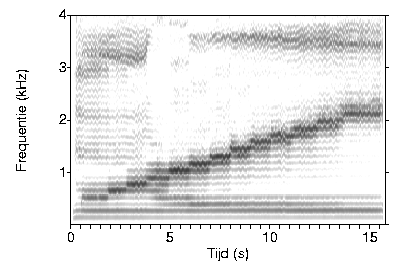

 |  |
singing | overtone singing - tuva overtone singing 1 - tuva overtone singing 2 - tuva overtone singing 3 - tuva overtone singing 4 - | |
overtone singing | ||
|
This is a demonstration of overtone singing. Overtone singing is an
articulatory technique in which a certain overtone is amplified. You
will hear a whistle over the drone of the fundamental and lower
harmonics. The first fragment demonstrates a technique which is especially used in the Western countries. The tongue is very slowly moved from the position of the vowel /O/ to the position of the vowel /i:/, resulting in a special scale of overtones. The fundamental remains the same in all cases! The careful somewhat retroflex articulation brings the second and third formant together, which amplifies the nearby overtone. The overtones 5-16 can be heard. To produce the overtones 3-5, one has to make a nasal sound and articulate from /o:/ to /a:/. The overtone is then amplified by the first formant, while the nasal anti-resonance creates the acoustic distinction between the amplified overtone and the lowest harmonics. In the subsequent demonstrations, we hear song fragments containing overtone singing, from the Tuva Republic in Mongolia. The technique is not essentially different from the Western technique, but glottal adducation is much higher (almost pressed singing). The Tuva people know a number of techniques, which are related to the fundamental frequency. In these fragments you will hear Sygyt which is typically produced with a pitch of 150-200 Hz. An other technique is Kargyra, with a characteristic low pitch of less than 60 Hz.
More information:
| listen to demonstration technical details text/transcript | |
 |
overtone singing Keeping a constant pitch of about 130 Hz, a professional Western performer sings a scale of the overtones 4 to 16. The narrow-band spectrogram  shows the amplification of the successive overtones. The lowest overtones are amplified by the first formant, the stepwise increasing resonance is the combination
of second and third formant. Higher formants are also visible. shows the amplification of the successive overtones. The lowest overtones are amplified by the first formant, the stepwise increasing resonance is the combination
of second and third formant. Higher formants are also visible. | |
 |
tuva overtone singing 1  A Tuva singer demonstrates his "throat singing" or overtone singing, in which individual overtones are amplified. These overtones are clearly visible in the spectrogram. A Tuva singer demonstrates his "throat singing" or overtone singing, in which individual overtones are amplified. These overtones are clearly visible in the spectrogram. | |
 |
tuva overtone singing 2  A Tuva singer demonstrates his "throat singing" or overtone singing, in which individual overtones are amplified. These overtones are clearly visible in the spectrogram. A Tuva singer demonstrates his "throat singing" or overtone singing, in which individual overtones are amplified. These overtones are clearly visible in the spectrogram. | |
 |
tuva overtone singing 3  A Tuva singer demonstrates his "throat singing" or overtone singing, in which individual overtones are amplified. These overtones are clearly visible in the spectrogram. A Tuva singer demonstrates his "throat singing" or overtone singing, in which individual overtones are amplified. These overtones are clearly visible in the spectrogram. | |
 |
tuva overtone singing 4  A Tuva singer demonstrates his "throat singing" or overtone singing, in which individual overtones are amplified. These overtones are clearly visible in the spectrogram. A Tuva singer demonstrates his "throat singing" or overtone singing, in which individual overtones are amplified. These overtones are clearly visible in the spectrogram. | |





 | ||